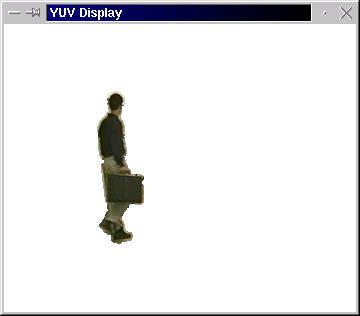| |
|
|
|
Video object extraction
|
 |
Many
computer vision problems require change detection as their
preliminary step. Change detection is a process of identifying
differences in the state of objects or phenomena by observing
them at different times. Applications that benefit from change
detection are multimedia, advanced video surveillance, remote
sensing, interactive and immersive gaming to mention a few. They
require efficient and accurate procedures to detect and to label
the changes in image sets or image sequences.
Here on the left, you can see the result of a novel technique
for the extraction of multiple moving objects (the detected
objects are shown, while the background is color-coded in
white).
|
|
Video object tracking
|
| |
Object-based
coding and description offer a new range of capabilities, where
the objects are separately coded and described. Industry
standards, such as MPEG-4 and MPEG-7, provide the user with
flexibility in content-based access and manipulation of
multimedia data. To maximize the benefits of object-based
representation, these standards need to be complemented with
automatic techniques for
extracting the video objects from video data, a problem that
still remains largely unsolved.
An object-based representation requires therefore prior
decomposition of sequences into semantically meaningful,
physical objects. In a way, this corresponds to retracing the
steps in the video-creation
process. This complex problem can be formulated as one of
identifying objects in the scene and separating them from the
background. Tracking is a fundamental step in video object
extraction. In this
framework, the goal of tracking is to follow video objects in
the scene and to update their 2D shape from frame to frame.
After a frame of the image sequence has been segmented into
objects, the objects are
tracked in the subsequent frames. The aim of temporal tracking
is to establish a correspondence between instances of video
objects over frames.
By clicking
on the image on the left, you can see the result of a
tracking technique that exploits an image representation
as partition hierarchy and tracks video objects based on
interactions between different levels of the hierarchy. The
hierarchy is composed of a semantic level and a region level.
The semantic level defines the topology of the video objects.
The region level defines the topology of homogeneous areas
constituting the objects.
Collaboration
Olivier Steiger

|
|
Shadow detection in video
sequences
|
 |
Shadows can
provide important information about the scene represented in a
digital image. They contain cues about the shapes and the
relative positions of objects, as well as about the
characteristics of surfaces and light sources in the scene. On
the other hand, the presence of shadows represents a problem for
applications requiring the identification of objects through
segmentation. The shape and the color of segmented objects is in
fact modified by the presence of shadows. Therefore, in order to
provide a correct description of the objects, shadows have to be
identified.
Here on the left, you can see the result of a novel technique
for shadow recognition (the detected shadows are color-coded in
green).
Collaboration
Elena Salvador
|
|
Semantic transcoding
|
 |
By
clicking on the image on the left, you can see the result
of an automatic content-based video transcoding algorithm which
is based on how humans perceive visual information. The
transcoder support multiple video objects and their description.
First the video is decomposed into meaningful objects through
semantic segmentation. Then the transcoder adapts its behaviour
to code relevant (foreground) and non relevant objects
differently. Both object-based and frame-based encoders are
combined with semantic segmentation. Experimental results show
that the use of semantics and description prior to transcoding
reduces the bandwidth requirements and makes it possible to
adapt the video representation to limited network and terminal
device capabilities still retaining the essential information.
Collaboration
Olivier Steiger
|
|
|
|
| |
|
|
| |
|
|
|
|
|
|
 |
|
 |